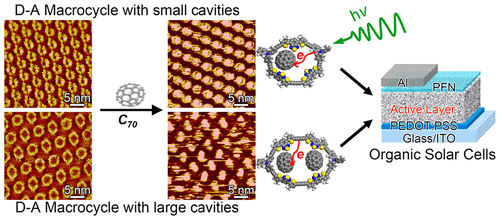Our official English website, www.x-mol.net, welcomes your
feedback! (Note: you will need to create a separate account there.)
Donor–Acceptor Conjugated Macrocycles: Synthesis and Host–Guest Coassembly with Fullerene toward Photovoltaic Application
ACS Nano ( IF 15.8 ) Pub Date : 2017-11-15 00:00:00 , DOI: 10.1021/acsnano.7b06961 Si-Qi Zhang 1, 2 , Zhen-Yu Liu 1 , Wei-Fei Fu 3 , Feng Liu 4 , Chuan-Ming Wang 5 , Chun-Qi Sheng 1 , Yi-Fei Wang 1 , Ke Deng 2 , Qing-Dao Zeng 2 , Li-Jin Shu 1 , Jun-Hua Wan 1 , Hong-Zheng Chen 3 , Thomas P. Russell 6
ACS Nano ( IF 15.8 ) Pub Date : 2017-11-15 00:00:00 , DOI: 10.1021/acsnano.7b06961 Si-Qi Zhang 1, 2 , Zhen-Yu Liu 1 , Wei-Fei Fu 3 , Feng Liu 4 , Chuan-Ming Wang 5 , Chun-Qi Sheng 1 , Yi-Fei Wang 1 , Ke Deng 2 , Qing-Dao Zeng 2 , Li-Jin Shu 1 , Jun-Hua Wan 1 , Hong-Zheng Chen 3 , Thomas P. Russell 6
Affiliation

|
Electron-rich (donor) and electron-deficient (acceptor) units to construct donor–acceptor (D–A) conjugated macrocycles were investigated to elucidate their interactions with electron-deficient fullerene. Triphenylamine and 4,7-bisthienyl-2,1,3-benzothiadiazole were alternately linked through acetylene, as the donor and acceptor units, respectively, for pentagonal 3B2A and hexagonal 4B2A macrocycles. As detected by scanning tunneling microscopy, both D–A macrocycles were found to form an interesting concentration-controlled nanoporous monolayer on highly oriented pyrolytic graphite, which could effectively capture fullerene. Significantly, the fullerene filling was cavity-size-dependent with only one C70 or PC71BM molecule accommodated by 3B2A, while two were accommodated by 4B2A. Density functional theory calculations were also utilized to gain insight into the host–guest systems and indicted that the S···π contact is responsible for stabilizing these host–guest systems. Owing to the ellipsoidal shape of C70, C70 molecules are standing or lying in molecular cavities depending on the energy optimization. For the 3B2A/PC71BM blended film, PC71BM was intercalated into the cavity formed by the macrocycle 3B2A and provided excellent power conversion efficiency despite the broad band gap (2.1 eV) of 3B2A. This study of D–A macrocycles incorporating fullerene provides insights into the interaction mechanism and electronic structure in the host–guest complexes. More importantly, this is a representative example using D–A macrocycles as a donor to match with the spherical fullerene acceptor for photovoltaic applications, which offer a good approach to achieve molecular scale p–n junctions for substantially enhanced efficiencies of organic solar cells through replacing linear polymer donors by cyclic conjugated oligomers.
中文翻译:

供体-受体共轭的大环:富勒烯的合成和主客体共组装在光伏应用中的应用
研究了富电子的(供体)和缺电子的(受体)单元以构建供体-受体(DA)共轭大环,以阐明它们与缺电子的富勒烯的相互作用。三苯胺和4,7-双噻吩基-2,1,3-苯并噻二唑通过乙炔交替连接,分别作为五边形3B2A和六边形4B2A大环的供体和受体单元。如通过扫描隧道显微镜检测到的,发现两个D–A大环在高度定向的热解石墨上形成了一个有趣的浓度受控的纳米多孔单层,可以有效捕获富勒烯。重要的是,富勒烯的填充取决于腔尺寸,仅使用一个C 70或PC 71容纳在由BM分子3B2A,另外两个被容纳4B2A。密度泛函理论计算还用于深入了解主客体系统,并指出S··π接触负责稳定这些主客体系统。由于C 70的椭圆形状,取决于能量优化,C 70分子处于或处于分子腔中。对于3B2A / PC 71 BM混合膜,尽管3B2A的宽带隙(2.1 eV),PC 71 BM仍可插入由大环3B2A形成的腔中,并具有出色的功率转换效率。这项有关富勒烯的D–A大环化合物的研究提供了对宿主—客体复合物中相互作用机理和电子结构的见解。更重要的是,这是一个具有代表性的示例,其中使用D–A大环作为施主,与光伏应用中的球形富勒烯受体匹配,这提供了一种很好的方法来实现分子级p – n结,从而通过替换来显着提高有机太阳能电池的效率环状共轭低聚物形成线性聚合物供体。
更新日期:2017-11-16
中文翻译:

供体-受体共轭的大环:富勒烯的合成和主客体共组装在光伏应用中的应用
研究了富电子的(供体)和缺电子的(受体)单元以构建供体-受体(DA)共轭大环,以阐明它们与缺电子的富勒烯的相互作用。三苯胺和4,7-双噻吩基-2,1,3-苯并噻二唑通过乙炔交替连接,分别作为五边形3B2A和六边形4B2A大环的供体和受体单元。如通过扫描隧道显微镜检测到的,发现两个D–A大环在高度定向的热解石墨上形成了一个有趣的浓度受控的纳米多孔单层,可以有效捕获富勒烯。重要的是,富勒烯的填充取决于腔尺寸,仅使用一个C 70或PC 71容纳在由BM分子3B2A,另外两个被容纳4B2A。密度泛函理论计算还用于深入了解主客体系统,并指出S··π接触负责稳定这些主客体系统。由于C 70的椭圆形状,取决于能量优化,C 70分子处于或处于分子腔中。对于3B2A / PC 71 BM混合膜,尽管3B2A的宽带隙(2.1 eV),PC 71 BM仍可插入由大环3B2A形成的腔中,并具有出色的功率转换效率。这项有关富勒烯的D–A大环化合物的研究提供了对宿主—客体复合物中相互作用机理和电子结构的见解。更重要的是,这是一个具有代表性的示例,其中使用D–A大环作为施主,与光伏应用中的球形富勒烯受体匹配,这提供了一种很好的方法来实现分子级p – n结,从而通过替换来显着提高有机太阳能电池的效率环状共轭低聚物形成线性聚合物供体。










































 京公网安备 11010802027423号
京公网安备 11010802027423号